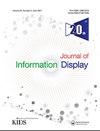高效深蓝(CIE ~ 0.08)荧光团基苯并咪唑与杂化的局部和电荷转移(HLCT)激发态的oled
IF 3.4
3区 工程技术
Q2 MATERIALS SCIENCE, MULTIDISCIPLINARY
引用次数: 3
摘要
开发国际照明委员会(CIE)y值<0.1的高效深蓝色荧光团对显示技术具有重要意义。在此,我们设计并合成了一种热稳定的深蓝色发射材料3-(2-(4′′′-(1-苯基-1H-苯并[d]咪唑-2-基)-[1,1′:4′,1〃-三苯基]-4-基)-1H-菲并[9,10-d]咪唑-1-基)苄腈(MCNPIBI),通过整合适度的供体和受体,即,菲并咪唑(PI)和在PI的N1位置具有氰基苯基(-CN)基团的苯并咪唑,以将CT组分调谐到激发态。系统的理论和光物理研究揭示了具有杂化局域和电荷转移(HLCT)激发态的MCNPIBI。时间相关密度泛函理论(TD-DFT)计算表明,MCNPIBI中的反向系统间交叉(RISC)过程发生在从高位三重态到单线态的过程中。此外,合成的深蓝色发射材料被用作多层有机发光二极管(OLED)器件中的掺杂剂,从而产生发射波长为447的深蓝色电致发光(EL) nm和CIE坐标为(0.150.08),这接近NTSC建议的蓝色发射器的标准值(0.140.08)。OLED器件显示2.78的最大电流效率 cd A−1,最大功率效率为1.94 lm W−1,最大外量子效率分别为3.69%。此外,OLED器件具有3.8的低接通电压 五、本文章由计算机程序翻译,如有差异,请以英文原文为准。
Efficient deep blue (CIE ∼0.08) fluorophore-based benzimidazole with hybridized local and charge transfer (HLCT) excited state for OLEDs
Development of efficient deep blue fluorophore with Commission Internationale de l’Eclairage (CIE)y value <0.1 is of great importance for display technology. Herein, we designed and synthesized a thermally stable deep blue emissive material 3-(2-(4′′-(1-phenyl-1H-benzo[d]imidazol-2-yl)-[1,1′:4′,1″-terphenyl]-4-yl)-1H-phenanthro[9,10-d]imidazol-1-yl)benzonitrile (MCNPIBI) by integrating moderate donor and acceptor, namely, phenanthroimidazole (PI) and benzimidazole with cyanophenyl (-CN) group at N1 position of the PI to tune the CT component in the excited states. The systematic theoretical and photophysical study reveals the MCNPIBI with hybridized local and charge transfer (HLCT) excited states. Time-dependent density functional theory (TD-DFT) calculation suggests that the reverse intersystem crossing (RISC) process in MCNPIBI occurs from high-lying triplet states to a singlet state. Furthermore, the synthesized deep blue emissive materials were employed as dopants in multilayer organic light emitting diode (OLED) devices, thus resulting in deep-blue electroluminescence (EL) with an emission wavelength of 447 nm and CIE coordinates of (0.15, 0.08), which are close to the standard values for blue emitters, as suggested by NTSC (0.14, 0.08). The OLED device displays a maximum current efficiency of 2.78 cd A−1, a maximum power efficiency of 1.94 lm W−1, and a maximum external quantum efficiency of 3.69%, respectively. In addition, the OLED device has a low turn in voltage of 3.8 V.
求助全文
通过发布文献求助,成功后即可免费获取论文全文。
去求助
来源期刊

Journal of Information Display
MATERIALS SCIENCE, MULTIDISCIPLINARY-
CiteScore
7.10
自引率
5.40%
发文量
27
审稿时长
30 weeks
 求助内容:
求助内容: 应助结果提醒方式:
应助结果提醒方式:


